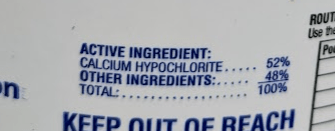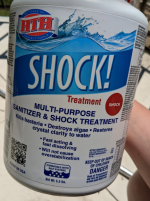Just trying to cover all the bases, how much does water cost in Vermont? Where I am the thinking for your pool might go something like this: water is about $8 / 1,000, liquid chlorine is about $5 / 1, above ground pool makes a full drain and clean and refill practical, drain, clean and refill would be under a hundred bucks,
I was wondering about draining before I started researching & wound up here. We haven't looked into it seriously, largely because the logistics of "where does the dirty water get pumped out to?" seems daunting. However, my husband also thought that the cost of refilling might be prohibitive, because just topping the pool off (maybe 10-18 inches? maybe a couple of feet?) at the start of the summer makes the water bill jump about $100. So refilling the whole thing would probably run at least $300-400 just in the cost of water alone, on top of the cost of actually getting the drainage done (I imagine, also a few hundred bucks). And given the age of this ol' thang, I wouldn't be surprised if the potential structural concerns of drainage would be... you know, concerning!
I've ordered tests, the whole big fancy kit n caboodle. My husband doesn't know yet... We'll have to discuss and I might definitely have some persuading to do re: ditching all the advice/techniques he's been working so hard to learn these last few years. It's not that he isn't committed to fixing this pool... It's rather that he's been doing it all himself since we bought this house, and it has been tons of work. I think it's going to be hard to hear me coming off of one of my internet research spirals and saying "Hey honey, I think you've been doing it all wrong. I'm confident that my several hours of reading trumps your 5 years of blood, sweat, & tears (and advice from supposed experts)!"
When I poke around on Reddit, & Amazon reviews of the TFP book, I see a few complaints that TFP is "cultish" and possibly in the pockets of... saltwater pump manufacturers, I guess? Although in my (currently limited) exposure so far, I'd expect anyone claiming conflict of interest or commercial bias to focus on the test kit vendors that your supporters get discount codes for, or something...
(Not trying to throw shade, just sharing my thought process as I try to educate & orient myself to this world.)
BUT anyways, I haven't yet come across anyone actually saying the advice & science proffered here are flawed, just that you all tend to be more condemning of "conventional" methods than they deserve. To be fair, until this year's caterpillar fiasco, our pool was just fine following Pool World's advice.
But intuitively, it really does appeal to me to be more in control of testing, & be able to do it on the spot, & actually understanding the details, & re-test frequently; rather than just dropping off a sample at the pool store a few times per season. And when the water is visibly filthy like now, they say don't even bother testing it, keep shocking & running the pump till it looks clearer!
I do think that currently the fine sediment of dissolved caterpillar poop probably poses as much, or more, of a A physical problem than a chemical/balance problem. Although maybe the poop is also feeding algae to an extreme degree, severely compounding the filtration problem in a way that seriously upping the chlorine would mitigate?
I've purchased a self-contained hand
vacuum that should get here in a few days, as well as some supplemental
filters that will supposedly help capture very fine silt. Hopefully that'll help get the layer of gunk off the bottom.
We already had a vacuum, but husband wasn't using it because it's one that just sucks water into the pump to be filtered--and our main problem is how fast that pump filter clogs already, ergo this wouldn't actually do anything to make our lives easier!
He's been swapping & cleaning filters daily, but it looks like in a perfect world we'd want to be doing it 4x/day. After we replaced it yesterday, around 4PM, we came home after dinner, maybe around 8, and he pointed out how you could already see just from looking at the pool how it had lost flow almost entirely--in other words, clogged again in under 4 hours.
The problem with changing the filter more is A) It's a MASSIVE pain in the neck. Beyond just how long it takes & how messy it is, it is actually really hard to unscrew the cap to get the filter out. And the caterpillar hairs. He suits up (in the heat) in a windbreaker & gloves to do it, to avoid getting itchy dermatitis all over. And B) It's time-consuming! We both work full time, we have a small child, we have a million other household things going on... We're comfortable but we aren't rich enough to outsource our laundry cooking yardwork cleaning & pet care. And we don't have 4 hours every day to rotate filters.
So... I have high hopes for the non-pump-dependent vacuum to help us make some big progress here by sucking the silt layer off the bottom, independently of changing the chemical regimen. (I will also be doing the hairnet trap basket thing-- I got the pool-specific ones and the hairnet ones, to compare performance on each! Note for posterity: I've seen a warning not to put these nets around the
outside of the basket, as there is a good chance of it getting sucked down into the pipes! So I'm hoping it's not hard to secure to the inside of the basket.)
I think I had some questions I wanted to ask, but I need to get a move on some non-pool chores today, so maybe I'll save them till after I get through more of the Pool School articles.
By the by, is there a cheatsheat/glossary anywhere for all the acronyms in use around here? I keep forgetting what different ones stand for & having to look it up all over again. (EDIT-nevermind, I found
the glossary)





